The Timeless Wisdom of Saint John Chrysostom’s Homilies On The Statues
Saint John Chrysostom, recognized as one of the greatest Early Church Fathers, has left a lasting mark on Christian theology and pastoral care through his numerous writings. Among his most celebrated works are the Homilies on the Statues, which provide a profound glimpse into his rhetorical brilliance and deep theological insights.
This blog post contains affiliate links. When you click on a link on this page and make a purchase I may earn a small commission, at no additional cost to you. Thank you for your support.
The Historical Context
The Homilies on the Statues were delivered in 387 A.D. during a tumultuous period in the city of Antioch. The residents, aggravated by high taxes, revolted and caused extensive property damage, including the destruction of statues representing the emperor and his family.
Fearful of imperial retribution, the city fell into deep anxiety. It was in this period of crisis that Saint John Chrysostom delivered his homilies.

The Content of the Homilies
Saint John Chrysostom’s Homilies on the Statues consist of 21 discourses that can be broadly categorized into several key themes:
Call to Repentance and Faith
John Chrysostom’s initial homilies focus on calling the citizens of Antioch to repentance and faith. He emphasizes the importance of turning away from sin and seeking God’s mercy with a contrite heart. His compassionate and urgent plea reassures the people of God’s forgiveness and loving kindness.
Divine Providence and Justice
In his homilies, Chrysostom eloquently elaborates on the concepts of divine providence and justice. He comforts the anxious populace by explaining that God’s justice is ultimately fair and that the events happening around them are part of God’s larger plan. His arguments serve to restore faith and trust in divine wisdom.
Moral and Ethical Instruction
Chrysostom uses the crisis as a teaching moment to instill moral and ethical values. He addresses various aspects of daily life, encouraging honesty, humility, charity, and patience. By drawing on scriptural examples and personal anecdotes, he effectively connects theological doctrines to practical living.
The Intercession of the Saints
Another recurring theme in these homilies is the intercession of the saints. Chrysostom reminds the people of the powerful intercession of martyrs and saints on behalf of the city. This emphasis on communal prayer and solidarity strengthens the citizens’ spiritual resolve and unifies them in their common faith.
The Rhetorical Mastery
Saint John Chrysostom’s homilies are also a testament to his unparalleled rhetorical skills. His ability to employ vivid imagery, logical reasoning, and emotional appeals showcases his mastery of Greek oratory. The amalgamation of theological depth and rhetorical flair makes these homilies both intellectually and emotionally stirring.
The Enduring Legacy
The Homilies on the Statues continue to resonate with readers today due to their timeless wisdom and pastoral sensitivity. They provide invaluable lessons on dealing with crises with faith and humility. Moreover, they stand as a shining example of the power of eloquent preaching in transforming hearts and minds.
Saint John Chrysostom’s insights and teachings in these homilies remain a guiding light for believers seeking to deepen their understanding of faith and navigate the vicissitudes of life with grace and resilience.
In conclusion, the Homilies on the Statues serve not only as a historical document but also as a timeless spiritual guide, emphasizing repentance, divine justice, moral rectitude, and the power of intercessory prayer. They encapsulate the wisdom and spiritual fervor of one of Christianity’s most revered preachers and continue to inspire and instruct generations.
Looking for unique Catholic gifts? Check out our gift guide!
